The plan with the velodrome was to make it as lean as a racing bike, says Chris Wise, one of its designers
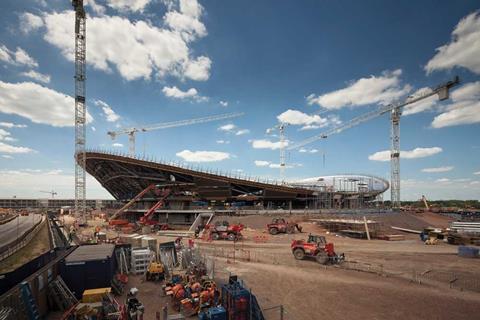
The roofs of the 2012 aquatics centre and velodrome are of a similar shape and size. However, whereas the former contains 3,000 tonnes of steel, the velodrome roof is held up with just 100 tonnes. This is reflected in a radical difference in budget (£250m vs £95m), but also in the technical solutions that were used.
If this lavish use of steel for the aquatics centre seems extravagant, remember that it was the jewel in the crown of the UK’s Olympic bid and was instrumental in winning the Games for London. Other venues, like the warehouse-like media centre, were deliberately designed as simple, unadventurous structures so that they would be easy and cheap to build, and a cash-conscious public couldn’t accuse the government of wasting public money on architectural fripperies.
But the parsimonious use of steel in the velodrome roof in no way indicates that this is a mean building. The designers have turned economy into a virtue and created an elegant, considered structure that includes its own brand of roof dramatics. “We were trying to create something as lean and honed down as a racing bike would be - maximum performance from minimal materials,” says Chris Wise, director of structural engineer Expedition. “The natural beauty would come out of this as it does with performance bikes, fast cars and women.”
Chris Boardman on cycle technology

If anyone knows what an Olympic cyclist needs from his bike, it’s Chris Boardman. Famous for winning a gold medal at the 1992 Barcelona Olympics on a specially developed bike and three times holder of the Yellow Jersey in the Tour de France, Boardman has gone on to run his own successful bike company. He now heads up the Secret Squirrel Club, the R&D team focused on squeezing every last ounce of performance out of the British cycling team ready for London 2012.
Despite Boardman’s focus on the bikes, he says the technology is less important than it used to be. There is a minimum weight limit of 6.8kg for Olympics bikes and ultra-light wheels make for good acceleration, so weight has to be added to the frame. Extra material on the frame is no bad thing as it makes it stiffer which results in less flex and therefore less wasted energy. On longer road events, a stiff frame means a harsh ride that would fatigue the riders. “On the track you’ve got a very smooth surface and the event is very short so you keep the bike as rigid as possible,” he explains.
Approaching the limits of cycle technology doesn’t daunt Boardman. “It doesn’t matter how complex the rules are, there are always ways to innovate,” he says. “Our focus has gone away from equipment, it’s now on conditioning and positioning.”
For Boardman, aerodynamics is “huge”, accounting for 90% of a rider’s output. Olympic rules stipulate that the bikes have to stay looking like bikes, which rules out more aerodynamic designs such as recumbents. “What they are trying to do is keep it looking like cycling rather than human-powered machinery,” Boardman says. This means making the rider assume the most aerodynamic position possible within the rules without affecting their output. Boardman has spent the last few days with Chris Hoy in a wind tunnel to find the most efficient riding position. “A lot of this does depend on the riders. Chris is prepared to suspend reality and experiment,” Boardman says.
Boardman isn’t going to let on what those tests reveal, though the result will be a case of tweaking rather than a radical change. “If you’ve got 1,000 things and you improve each one by a fraction it adds up to a significant amount,” he says. We will have to wait two years to see what those fractional improvements amount to.
Structural design
The first step in realising this philosophy was to make the building as compact as possible. “We took the seating bowl and shrink-wrapped the building around it with the sight lines you need to see the track,” explains Mike Taylor, senior partner at Hopkins Architects. He describes the velopark as like a “fried egg - the velodrome is the yolk and the white is the BMX track and the rest of the velopark.”
Because the building is wrapped around the oval track, it takes a similar shape. It has a concrete base with 48 concrete piers arranged radially around the building. The seating is banked in two tiers with the entrance and public circulation area in the middle, to make access easier. The concrete piers end at the top of the public circulation space with a steel frame taking over the job of supporting the roof. This is angled outwards to follow the banking of the seating. The roof follows the height of the tiers of seats, which are minimal at each end of the track and more in the middle, giving the roof its distinctive Pringle shape. The steelwork ends in a ring beam to which is attached a cable net spanning across the length and width of the velodrome. This works in tension to support the roof and is the reason why the roof structure is so light.
Wise explains that the steelwork and roof are a highly efficient structure. The 48 steel trusses sitting on those concrete piers are linked together to form a monocoque structure. “Because the trusses are linked together, it acts as one 130m-diameter megastructure rather than as 48 separate pieces, which is much more efficient,” says Wise. The roof is curved in both directions which is also an efficient structural form - a flat roof would require four times as much structure to support the same amount of weight.
The second reason why the building is so efficient is because the cable net and steelwork act as one structural unit as well. When the velodrome fills up with people, their weight will force the angled sides of the building outwards. But these forces are restrained by the cable net which is tying all the steelwork together. All that happens is the centre of the roof will rise up as the tension in the cables increases. The most visible manifestation of this efficiency is the size of the ring beam at the perimeter of the roof. This only takes a quarter of the loads found in a building where the roof is a separate structural element, so the ringbeam can be much smaller and the roofline more elegant.
There is one downside to the design, which Wise acknowledges. “The consequence of all this elegance in the superstructure means there are some considerable forces that have to be taken out in the ground,” he says.
All the people sitting in the building makes the angled sides want to splay outwards.
At the ends where there are very few spectators the weight of the roof has the opposite effect. In technical terms this means that where all the people are sitting, the side of the concrete pier next to the track is under tension, and the other side next to the building perimeter is under compression. These forces have to be resisted in the ground. Unfortunately, the building sits over the old West Ham landfill tip, which means the ground is quite literally rubbish. Because of this, those forces can’t be dealt with by bolting the building to solid ground. The compressive forces are dealt with using big piles, and the tensile forces are balanced out by sheer weight of concrete in above-ground “bookend”-type structures.
What does Wise think about the fact the aquatics centre roof uses 30 times more steel than the velodrome? “Draw your own conclusions,” he says. “We set out to make ours as light as possible so I believe ours is more efficient than the aquatics centre. But I do respect the fact the aquatics centre was an essential part of getting the Olympics for London without which there would have been no velodrome, so thanks very much Zaha for that. It’s a way of bringing the Games to London with all the benefits which go with that and that is much more than just embodied carbon.”
Chris Hoy on what makes a great track

With three gold medals under his belt at the Beijing Olympics, cyclist Sir Chris Hoy was the obvious person to help ensure this would be the best possible velodrome. He joined design luminaries including Tate Gallery director Sir Nicholas Serota and former RIBA president Sunand Prasad on the judging panel of the design competition, and quickly suggested some ideas to improve on the velodromes he had competed in before. These had seating along the straights but not at the ends where the steeply banked track makes it hard for spectators to see the action. However, cyclists find it disconcerting to cycle past cheering crowds only to hit silence at each end of the track, so three tiers of seating are being squeezed in the ends on the London 2012 velodrome without compromising views.
The second key area was maintaining constant temperatures. Hoy wanted this velodrome to help cyclists break new records so the track area will be maintained at a constant 28°C. The idea is that the air is thinner at this temperature, meaning less wind resistance. The air also had to be still. This has been managed by providing two sets of doors to outside areas to stop draughts.
“It’s great to see that many of the areas we discussed during the design competition have been taken on board and I’m confident the velodrome will be an amazing facility,” says Hoy.
Building the velodrome
Building cable net structures is a job many contractors shy away from but builder ISG has turned it to its advantage. Barring the complex geometry involved, it has meant minimal working at height, virtually no temporary works (unlike the aquatics centre) and it has helped enormously with the two-year programme.
Getting to the cable net stage was relatively straightforward and occupied the team for the first year of the job. This included the concrete works for the slab, “bookends” and piers followed by the structural steelwork. This was made more geometrically challenging by the effect of the precast seating, which pulls the steelwork outwards and the weight of the roof, which pulls it back in again.
Like the building, constructing the cable net was simple. The 36mm diameter cables were delivered to site exactly the right length complete with end fixings. The cable net, which looks like the strings of a giant tennis racket, was laid out on the ground. A special node for supporting the roof panels was attached where the cables intersect. Once the cable net was assembled, secondary cables were attached to the ends of those making up the cable net. These were hooked over special spigots on the structural steel ringbeam, which means that when these secondary cables are tensioned, the cable net is pulled up into position.
Once the cable net was a metre off the ground, safety netting was installed under the areas where the rooflights were due to be fitted, as this minimises the amount of working at height. Strand jacks were used to pull the cable net into its final position - this is secured in place using metal pins. The roof structure took just eight weeks to complete. “We were within a couple of millimetres from where Expedition thought we would be when we finished the cable net,” says Davendra Dabasia, the project manager on the velodrome for delivery body CLM.
Prefabricated timber cassettes have been used to cover the roof structure. These consist of birch-faced plywood on the underside and OSB on top with separating ribs, and were simply dropped into position. These fit in between the cables and are supported by the nodes at the intersection of the cables. “They’re like upside-down floor tiles,” says Dabasia. “You can get one in place in 10-12 minutes so it’s a very quick operation.” These were installed working from both ends to ensure the cable net was evenly loaded.
The cassettes come ready-topped with a waterproof membrane called Alutrix. Strips of the same material are used to seal the gaps between the panels. This will be topped with insulation and finally a Kalzip standing seam roof. The reason for the Alutrix membrane is to enable work to start on the lights and track before the Kalzip is finished. “The waterproof cassettes de-risk the project which takes the Kalzip off the critical path,” explains Dabasia. “The risk with other velodromes is the roof leaking onto the track.”
Chris Wise on winning the velodrome
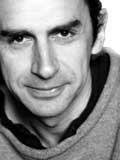
Chris Wise is the man (partly) behind the ultra-lean velodrome structure. He is very reluctant to see anyone singled out for praise and stresses that the design was a team effort. Indeed, he says this team approach was instrumental in structural engineer Expedition Engineering, Hopkins Architects, services engineer BDSP and landscape architect Grant Associates winning the job. “They wanted to choose a team not a scheme,” Wise says, adding the procurement rules were still evolving so the ODA wanted an open-minded team capable of delivering a quality building on budget and quickly despite a constantly changing brief.
The judges also liked the team’s ideas. “They said we were so in tune with the brief it was as if we had ridden in on our bikes,” laughs Wise. A key factor in winning the competition was the idea of providing the entrance and exit concourse halfway up the building. Not only does entering the seating halfway up the bowl speed up access, it also means spectators get good views over the Olympic park. “The judges really liked the inside-outside connectivity as it brought the rest of the Olympics inside the building,” explains Hopkins’ Mike Taylor.
The Pringle-shaped roof was selected for its efficiency - a double-curved roof is four times as efficient as a flat one and this building is all about efficient, finely honed design. But there was one highly-efficient design solution that dared not speak its name. The design team conveyed its idea for the cable net roof by showing the judges a traditional Brooks bicycle saddle - representative of the roof shape - and a spider’s web - the cable net. “At the presentation we said we were trying to get the saddle to shag the spider’s web. We didn’t mention the word ’cable net’ as we thought we would lose the competition,” says Wise, explaining that cable nets are seen as risky and expensive. Instead the team proposed building the roof structure from steel tubes, then changed this to steel tubes in tension and wood in compression, then finally an all-timber roof.
It wasn’t until a contractor was appointed nearly a year later in May 2008 that cable nets were mentioned in polite company and that was down to contractor ISG. “They said it should be a cable net and we said that’s fantastic, that’s what we’ve wanted from the beginning,” says Wise, adding that ISG reckoned a cable net could save two months on the programme. “ISG did what any good contractor should do, took the idea on the table and improved it.”
Fast track
Once the lighting is installed, and the scaffolding for this removed, work can start on the track. This has been specified by renowned velodrome track specialist Ron Webb. The banking ranges from 15° in the middle to 47° at the ends. Wooden trusses are used to span between the steelwork next to the seating and the concrete safety zone on the inside of the track. “It would have been easier to do these in steel but Ron insisted on wood as this is what he always uses and didn’t want to deviate from that,” says Dabasia.
Once these are in place, 6m lengths of Siberian larch, which are 40mm square in section, are simply nailed down to the wooden trusses just like laying a wooden floor. Western hemlock was also tested as a track material and performed as well as the Siberian larch. “Both are very stable timbers and don’t move much with temperature. We’ve gone with the larch as it was easier to bend around the corners and Ron has used it on other tracks,” says Dabasia.
One of the requirements of the British cycling team was that the velodrome should be kept at a constant 28°C at track level. This is because the team believes the air is less dense at this temperature, which allows less wind resistance and more speed. Because of this, the building’s primary servicing need is heat rather than cooling. Underfloor heating is used in the central area next to the track and warm air can be blown in at upper levels. The building is naturally ventilated - air is drawn in through slots under the seats and out again at high level through the cladding. Air handling units are there for backup in case things get really hot in August 2012.
Velodrome In numbers
- 6,000 capacity - 3,500 around the track and 2,500 in upper tiers suspended within the curves of the roof
- 48,000m3 of material excavated to create the bowl - enough to fill 19 Olympic-sized swimming pools
- 2,500 sections of steelwork form curved steel structure
- Rises in height by 12m from shallowest point to the highest
- Roof has 16km of cabling and covers an area of 5,000m2. It took eight weeks to lift into place
- At 30kg/m2, the roof weighs roughly half that of any other covered velodrome
- Includes a 250m track and 100m warm-up circuit
Photography by Tim Crocker/the ODA




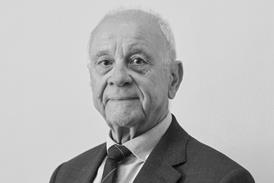





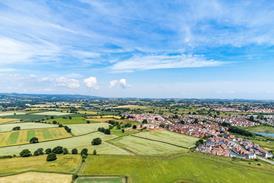
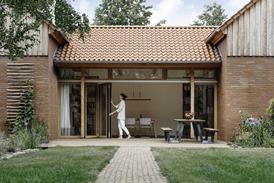
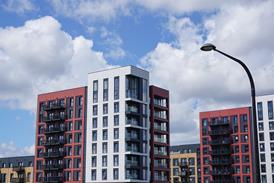

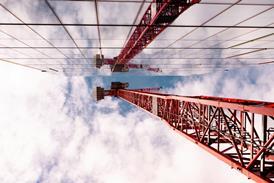
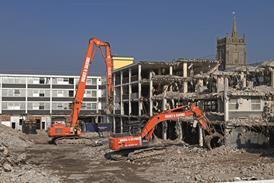









No comments yet